Sayer Ji
Aug 30, 2025
Read, comment and share the post on X dedicated to this topic: https://x.com/sayerjigmi/status/1961930188734046562
Deep in the hive, a humble larva is anointed with a mysterious elixir and emerges as royalty. This mysterious substance -- royal jelly -- has captivated beekeepers, scientists, and alchemists alike for its seemingly magical ability to create a queen bee from an ordinary worker. In recent years, modern science has begun to unravel the biochemical secrets behind royal jelly's transformative power. What's coming to light is a remarkable story of nutrigenomics, epigenetics, and cross-species rejuvenation, bridging ancient mythic symbolism with cutting-edge biology. Royal jelly is not just a nutritious food; it is a molecular message, a cross-kingdom communication that can sway development, longevity, and healing across species. This essay explores the queen-maker's secrets -- from the hive's caste system to the discovery of a mammalian "royal jelly" protein called Regina -- and how they revolutionize our understanding of nourishment, regeneration, and the deep interconnectedness of life.
A Queen is Born: Royal Jelly and the Making of Monarchs
All honeybees are born equal, but nutrition decides their fate. In a beehive, worker bees and the queen share an identical genome, yet they become starkly different in form and function¹⁻². Worker bees toil for a few weeks and remain sterile females. The queen, by contrast, grows larger, lays eggs, and can live for years -- up to 10 times the lifespan of a worker¹⁻³. The secret to this royal longevity and fertility is royal jelly (RJ), a creamy, white secretion fed exclusively to the chosen queen-destined larva.
Every honeybee larva receives royal jelly for the first three days of life, but only those selected to be queens continue to be fed this exclusive "royal" diet. All others are weaned onto a mix of pollen and honey (called beebread) and will develop as workers⁴⁻⁵. The presence or absence of royal jelly triggers a dramatic developmental divergence. The queen larva, bathing in an abundance of RJ, grows significantly larger ovaries and a different physiology than her worker sisters³⁻⁶. This phenomenon baffled scientists for ages -- how can food alone create a queen? The answer lies in bioactive compounds in royal jelly that act like developmental signals rather than mere nutrients⁷⁻⁸.
[Figure source: https://www.mdpi.com/1422-0067/21/2/382]
Royal jelly is often dubbed "bee milk," and for good reason. Produced by young nurse bees' hypopharyngeal and mandibular glands, RJ is a milky, nutrient-rich secretion -- analogous to mammalian milk -- that serves to nourish and program the development of the bee larva⁹⁻¹⁰. It contains a complex blend of proteins, sugars, fatty acids, vitamins, and hormones, making it a veritable superfood⁷. But what truly sets RJ apart is its suite of specialized proteins and epigenetic factors that can flip genetic switches. One protein in particular drew early attention: a 57-kilodalton glycoprotein dubbed "royalactin." Researchers in 2011 identified royalactin as a key molecule in RJ responsible for queen development¹¹⁻¹². When isolated and fed to bee larvae, royalactin alone was sufficient to induce queen-like traits -- larger size, developed ovaries, accelerated maturation¹². Amazingly, it even inducedthese effects in fruit flies, a distant insect relative¹³⁻¹⁴. This suggested that royal jelly's influence works via conserved biological pathways.
The discovery of royalactin showed that royal jelly acts as a developmental bio-hormone, not just a high-protein diet. By activating signaling pathways (notably the Egfr/EGF receptor pathway) in the larva, royalactin triggers a cascade of gene expression changes that yield the queen phenotype¹⁵⁻¹⁴. In essence, royal jelly is a trigger: it switches on the genetic program for queen development that is latent in every female bee. The other larvae, deprived of continuous RJ, default to the worker pathway. Some researchers describe this as "nutritional castration" -- the workers aren't so much lacking a queen-promoting factor as they are exposed to inhibitory factors in a normal diet that suppress queenly development¹⁶⁻¹⁷. In fact, recent insights show that the regular worker diet (pollen and honey) contains compounds that actively repress growth and reproduction, whereas royal jelly lacks those repressors and adds its own boosters.
Nutrigenomic Alchemy: Food as Genetic Fate
Royal jelly exemplifies "nutrigenomics" in action: it is food that carries specific genetic instructions. The queen-making power of RJ arises from its influence on gene expression, achieved through epigenetic modifications and regulatory molecules. In the honeybee, epigenetics -- heritable changes in gene activity without DNA sequence change -- underlies caste differentiation¹⁸⁻¹⁷. Both queens and workers have the same DNA; what differs is which genes are turned on or off, and royal jelly is the environmental trigger that sets this pattern.
One major epigenetic mechanism at play is DNA methylation. Studies have shown that worker and queen bees develop distinct DNA methylation patterns, correlating with their divergent anatomies and behaviors¹⁹⁻²⁰. Royal jelly seems to modulate the bee's methylation machinery. Notably, researchers found that royal jelly contains compounds that inhibit DNA methyltransferase enzymes (like DNMT)²¹. By suppressing DNA methylation on key developmental genes, RJ keeps those genes active in the queen larva that would otherwise be silenced in a worker. In one striking experiment, silencing the gene for a DNA methylase in bee larvae (thus globally reducing DNA methylation) caused many larvae to develop into queens even without royal jelly¹⁹. This suggests the worker fate is a methylation-driven default, and RJ works by preventing that methylation from locking in the worker program¹⁹.
[Figure source: https://www.mdpi.com/1422-0067/21/2/382]
In parallel, histone modification is also involved -- royal jelly has been reported to contain histone deacetylase (HDAC) inhibitors such as certain fatty acids (e.g. 10HDA), which would keep chromatin in a more open, active state²²⁻²³. Indeed, 10-hydroxy-2-decenoic acid (10-HDA), a fatty acid unique to royal jelly, has been shown to possess HDAC-inhibitory activity and other epigenetic effects²². By multiple epigenetic avenues, royal jelly unleashes the full genetic potential of the larva.
Perhaps the most astonishing discovery in recent years is that it's not only what royal jelly provides, but also what it lacks, that matters. Plant microRNAs -- tiny regulatory RNA molecules -- present in pollen and beebread were found to act as developmental brake pads. A 2017 study revealed that worker-destined food is enriched in certain plant-derived microRNAs that slow growth and reduce ovary development in bee larvae, pushing them toward the worker caste²⁴⁻²⁵. One of these plant microRNAs, called miR-162a, targets the gene amTOR (the honeybee version of the TOR growth regulator)²⁶. By dampening TOR signaling -- a pathway known to promote queen traits when active -- the plant miRNAs in a normal diet effectively inhibit queen development²⁴⁻²⁶. Royal jelly, being an animal-derived secretion, is nearly devoid of these plant miRNAs²⁷⁻²⁸. Freed from this inhibition, the queen-destined larva can develop rapidly and fully. It's a remarkable cross-kingdom interaction: flowering plants evolved miRNAs that end up in pollen, which, when fed to bee larvae, influence the bees' caste.
This cross-kingdom genetic communication represents part of what I described in my 2016 article below as the 'genetic dark matter' revolution—the discovery that non-coding RNAs serve as master regulators capable of transmitting epigenetic information between entirely different species.
Genetic Dark Matter and the Return of the Goddess
This article was written by Sayer Ji and first published on GreenMedInfo in 2016.
Through the lens of nutrigenomics, royal jelly is not a mere nutrient source but a developmental "social signal" encoded in both biochemistry and biosemiotic significance²⁹⁻²⁸. It carries instructions that activate queen-specific gene networks (like those for increased size, fertility, longevity) and deactivate others (like genes that would lead to worker sterility or foraging behavior). In honeybees, environmental information is literally fed to the genome: young larvae represent a "responsive phenotype" whose fate is determined by this early diet signal³⁰⁻³¹. This concept broadens to other organisms too -- our diets likely send genomic signals (consider folate or methyl-donors affecting human DNA methylation, for example³²). Royal jelly is thus a dramatic case study of how food can function as a developmental regulator, an idea with profound implications for understanding nutrition, aging, and health across the animal kingdom.
Regina: A Mammalian Analog to Royalactin
One of the most visionary leaps in royal jelly research came with the question: If royal jelly's royalactin can trigger youthfulness and growth in bees, could it affect other animals?
Scientists at Stanford decided to test royalactin on an unlikely subject -- mouse embryonic stem cells. The results, published in 2018, were nothing short of stunning. Royalactin prevented mouse stem cells from differentiating, effectively keeping them in a youthful "naïve" state, even without the usual growth factors³³⁻³⁴. Normally, stem cells in culture require a cocktail of signals (like LIF -- leukemia inhibitory factor) to remain unspecialized. Royalactin was able to replace those signals -- the stem cells continued to self-renew, generation after generation, without maturing³⁵⁻³⁶. In other words, something in royalactin was activating a core pluripotency network of genes that maintain the stem cell's youthful potential³⁷⁻³⁸.
This posed a fascinating puzzle: How could an insect protein influence mammalian cells? Mammals don't produce royalactin, and yet the mouse cells were clearly responding to it. The Stanford team hypothesized that evolution might have a parallel solution -- perhaps mammals have their own protein with a structure similar to royalactin that serves a similar function in early development³⁹⁻⁴⁰. Using computational protein modeling, they searched the mouse (and human) genome for proteins with a 3D shape that matches royalactin's unique structure. They found a hit: a previously unheralded protein called NHLRC3, which is expressed in early embryos across animal species (from fish to humans)⁴¹⁻⁴². When they produced NHLRC3 in the lab and added it to mouse stem cells, it mimicked royalactin's effects -- the cells stayed pluripotent and youthful, showing the same gene expression profile as when exposed to royalactin⁴³⁻⁴². This protein was essentially a functional analog of royalactin in mammals. Fittingly, the researchers renamed NHLRC3 "Regina," Latin for "queen"⁴⁴⁻⁴⁵.
The discovery of Regina is profound: it suggests that the ability to promote stem cell self-renewal -- to confer a kind of sustained youthfulness -- is not unique to bees, but is an ancient, conserved mechanism in biology³⁸⁻⁴⁶. Royalactin in the hive and Regina in the mammal may represent convergent solutions to triggering growth and regeneration. This opens up "broad implications in understanding the molecular regulation of stem cell fate across species," as the authors wrote³⁸⁻⁴⁶. It's as if royal jelly had pointed us to a hidden "fountain of youth" factor in our own biology.
[View publication: https://pmc.ncbi.nlm.nih.gov/articles/PMC6277453/]
The immediate excitement around Regina is its potential in medicine: Could we leverage it to improve stem cell cultures, tissue regeneration, or healing? The Stanford team speculated about using Regina (or royalactin itself) to enhance wound healing or regenerate tissues in adults⁴⁵⁻⁴⁷. After all, if it keeps embryonic cells young, might it rejuvenate adult cells too? As Dr. Kevin Wang, the lead researcher, remarked, "It's fascinating. Our experiments imply Regina is an important molecule governing pluripotency... We've connected something mythical to something real."⁴⁵⁻⁴⁸
"Bee Milk" and Mammalian Milk: Parallels of Instructive Nourishment
Royal jelly is often described as "bee milk," and the analogy is more than superficial. Much like a mother's milk shapes the development of a newborn mammal, royal jelly shapes the development of the bee larva. Both substances are nutrient-rich secretions evolved to feed the young, and both go beyond simple nutrition -- they carry informational molecules that guide growth, immune development, and metabolism of the offspring.
Compositionally, RJ and milk share some similarities: a high water content with proteins, sugars, lipids, vitamins, and hormones⁷⁻⁴⁹. Royal jelly's major proteins (MRJPs) and unique fatty acids (like 10-HDA) are specific to bees, but they serve a role akin to the bioactive proteins and fatty acids in human or cow's milk. Both contain antimicrobial components to protect the vulnerable young (royal jelly has royalisin and jelleins as antimicrobial peptides, while milk has lactoperoxidase and antibodies)⁵⁰⁻⁵¹. And intriguingly, both royal jelly and mammalian milk carry microRNAs and extracellular vesicles that can modulate gene expression in the consumer. Just as scientists have found maternal microRNAs in breast milk that might influence infant development and immunity³²⁻⁵², researchers have also identified microRNA profiles in royal jelly and even in honey that can affect recipients⁵³. This makes bee milk and mammal milk both "instructive foods," delivering signals that help program early-life development.
There are also parallels in early life "programming" and caste/social roles. Consider that in mammals, milk composition changes over time (colostrum vs mature milk) to meet the infant's developmental needs; in honeybees, the "formula" differs depending on whether the larva is to be queen or worker. In other words, nurse bees act somewhat like mammalian mothers, differential feeding their brood to shape their destiny -- one larva gets the superfood continuously to become the long-lived reproductive queen, while her sisters get a more austere diet and become the short-lived workers³⁰⁻⁵⁴. It's a striking example of how social insects use a milk-like secretion to exert social control and division of labor in the colony.
Cross-Kingdom Rejuvenation: From Worms to Humans
One of the most compelling aspects of royal jelly is its cross-species rejuvenating effects. The benefits of RJ are not confined to honeybees; they extend to organisms as simple as worms and as complex as mammals, hinting at conserved biological pathways that respond to this substance. Science is increasingly confirming folk wisdom that "what's good for the queen bee might be good for us."
[Spain's 8,000-year-old cave paintings in Valencia's Spider Cave show humanity's earliest record of honey hunting—daring climbers scaling cliffs with rope ladders to harvest wild bee products, revealing our ancient cross-species familiarity with these substances as treasures worth risking life to obtain.]
The ability of royal jelly to extend lifespan was first demonstrated in simple model organisms. In the nematode worm Caenorhabditis elegans, royal jelly supplementation prolonged lifespan by roughly 7--20% in various tests⁵⁵⁻⁵⁶. Fascinatingly, this effect was strongest not with whole RJ, but with specific fractions enriched in certain components -- pointing to defined molecules at work⁵⁷⁻⁵⁶. Researchers pinpointed 10-HDA, the fatty acid unique to RJ, as one such factor. 10-HDA alone was shown to extend the worm's lifespan, marking the first evidence that a single ingredient from royal jelly can increase longevity in a multicellular organism²²⁻²³. In these worms, RJ and 10-HDA triggered genetic changes reminiscent of caloric restriction or low-insulin signaling -- upregulating stress response genes and activating the longevity-associated FOXO/DAF-16 pathway⁵⁸⁻⁵⁹.
Similarly, fruit flies (Drosophila) fed royalactin lived longer and grew larger¹³. Even more impressively, there is evidence from rodent studies: one study noted that royal jelly supplementation in mice improved markers of aging and extended median lifespan⁶⁰⁻⁶¹. The precise longevity data in mammals is still limited, but the consistency of RJ's effects across worms, flies, and bees suggests a conserved pro-longevity mechanism⁶⁰⁻⁶¹.
Beyond lifespan, royal jelly exhibits an astonishing spectrum of pharmacological actions and therapeutic benefits in various animal models and human studies. According to comprehensive reviews of the scientific literature, RJ has at least ~84 distinct pharmacological activities and over 165 potential health applications documented in research⁶²⁻⁶³. In effect, it acts on multiple bodily systems:
Metabolic regulation: Royal jelly helps normalize lipid and glucose metabolism. Studies in rats showed RJ can improve cholesterol profiles and insulin sensitivity⁶⁴⁻⁶⁵. It doesn't just "lower cholesterol" in a simplistic sense, but rather modulates gene expression in the liver to promote a healthier balance of lipids⁶⁴. In fructose-fed mice, RJ prevented insulin resistance, hinting at anti-diabetic potential⁶⁵.
Neuroprotective and cognitive effects: In animal models of neurodegeneration and neural injury, RJ has demonstrated protective power. It reduced oxidative stress and neuron damage in the presence of heavy metal toxins⁶⁶⁻⁶⁷. Experiments indicate RJ can support cognitive function, improve memory in aging rats, and even promote neurogenesis (the growth of new neurons) in the brain⁶⁸⁻²². Such findings align with traditional uses of RJ for bolstering memory and vitality.
Hormonal balance and women's health: Royal jelly contains compounds with mild estrogenic activity, and research has found it beneficial for alleviating premenstrual and menopausal symptoms⁶⁹⁻⁷⁰. In one double-blind placebo-controlled trial, women taking daily RJ showed significant improvements in menopausal symptoms (such as mood, back pain, and urinary signs) compared to placebo, without the risks of hormone therapy⁷¹. RJ's adaptogenic quality -- helping the body adapt and normalize -- likely underlies these hormone-balancing effects.
Immune modulation and anti-inflammatory action: Perhaps one of RJ's most widely reported effects is its immunomodulatory capability. It can stimulate the immune system when needed -- for instance, boosting the production of immune cells -- yet also tame chronic inflammation by downregulating pro-inflammatory cytokines like TNF-α, IL-6, and the COX-2 enzyme⁷²⁻⁷³. This two-way tuning suggests RJ acts as a regulatory adaptogen rather than a blunt immune stimulant. In cell and animal studies, RJ improved antibody responses to vaccines, mitigated autoimmune reactions, and protected against endotoxin shock by tempering cytokine storms⁷⁴⁻⁷⁵.
Tissue repair and skin health: In line with its role for the queen (who must continuously regenerate her reproductive tissues), RJ exhibits remarkable wound-healing and regenerative properties. Applied topically or given orally, it accelerates wound closure, increases collagen synthesis, and improves skin elasticity⁷⁶⁻⁷⁷. One study showed RJ could protect skin from UV damage and photoaging by enhancing antioxidant defenses in the dermis⁷⁶.
Antimicrobial and anticancer effects: Royal jelly is a natural antimicrobial arsenal. It contains royalisin, a peptide effective against bacteria, and fatty acids like 10-HDA that show activity against bacteria, fungi, and even some viruses⁵⁰⁻⁵¹. Additionally, some components in RJ (e.g. specific proteins and phenolic compounds) have demonstrated anti-tumor properties in lab studies, such as inhibiting cancer cell proliferation and inducing apoptosis in certain cancer lines⁷⁸⁻⁷⁹.
A 2024 scientific review concluded that royal jelly's bioactive components underlie its "remarkable biological and therapeutic activities," from improving liver and kidney function to protective effects in metabolic syndrome and neurodegenerative diseases⁸¹⁻⁸⁰. This aligns with the fact that GreenMedInfo's database catalogs over 230 scientific abstracts on royal jelly, covering at least 165 different health conditions -- ranging from arthritis to cognitive decline -- which could benefit from RJ⁶²⁻⁸². Such numbers underscore that the queen's medicine is truly a treasure trove of healing.
Mythic Symbolism: Milk, Honey, and the Sacred Queen
Long before labs and journals, humans intuited something almost mystical about royal jelly and the bee products. The beehive has always been surrounded by an aura of sanctity and wonder in cultures worldwide. Our ancestors didn't know about epigenetics or Regina proteins, but they recognized in bees and their "milk and honey" the symbols of life, abundance, and even immortality.
[Depicted above is Neith, the ancient Egyptian goddess of creation and war, sometimes depicted as a bee. She represented creation, motherhood, and fertility, also representing the industrious nature of bees.]
In the ancient world, bees were often seen as messengers between the earthly and divine. The Egyptians held bees in the highest regard. One of the titles of the Pharaoh was nswt-bjt, "He of the Sedge and the Bee," linking the king's identity to the bee symbol. An Egyptian myth taught that bees were born from the tears of Ra, the sun god. When Ra wept, his tears fell to the earth and transformed into bees, who brought forth honey⁸³⁻⁸⁴. Here we see bees -- and by extension their nourishing products -- as literal gifts of the gods, born of divine sorrow to give life to the land.
In Greek mythology, bees and their products are woven into tales of gods and heroes. The infant Zeus, destined to become king of the gods, was said to have been nourished by a sacred mix of goat's milk and honey in a cave on Crete -- provided by the nymph sisters Amalthea (the goat) and Melissa (whose name literally means "bee")⁸⁵⁻⁸⁶. For her service of feeding Zeus honey, Melissa was rewarded and immortalized. This mythic scene strikingly pairs milk and honey as the sustenance of a god, echoing how royal jelly (bee "milk") and honey are the sustenance of a bee queen. The "land of milk and honey" in the Biblical tradition is another enduring symbol of a paradisiacal, life-giving abundance⁸⁷⁻⁸⁸.
Bees were sacred to Artemis and Demeter in Greek culture, and the priestesses of some Greek temples were called "Melissae" (bees), believed to bridge communication between the gods and humans. This ties to a widespread motif: bees as symbols of the soul or the divine spark. In some Mediterranean and Celtic folklore, bees were thought to carry messages to and from the spirit world⁸⁹⁻⁹⁰. Celtic tradition held that one must "tell the bees" of important family events (weddings, deaths), or else the bees might leave or perish⁹¹⁻⁹². In Hindu tradition and Buddhism, honey appears in allegories as well, symbolizing enlightenment or sweet reward (the Buddha was sustained in the wilderness by honey given by a monkey, commemorated in the Madhu Purnima festival⁹³⁻⁹⁴)
Mythically and spiritually, the figure of the Queen Bee herself resonates with archetypes of the Great Mother or the Goddess. She is the vital source of life for the hive, analogous to a mother goddess nurturing her people. The continuous virgin reproduction of the queen (who mates once and then lays eggs for years) had a mystical parallel to virgin goddesses or the idea of parthenogenesis (virgin birth) in myth. In a way, royal jelly is the physical substance that realizes the queen's divine status -- it creates her, sustains her, and is secreted by her attendant "priestesses" (the nurse bees).
Beyond Myth and Medicine: Toward a Visionary Synthesis
In the story of royal jelly and its ripple effects across species, we find a powerful motif: the unity of life through shared biochemical language. The queen's medicine, once a jealously guarded secret of the hive, now emerges as a symbol and tool for a new understanding of health and healing.
First, royal jelly challenges the conventional idea of food as mere calories and building blocks. Instead, it highlights a primary thesis of my book REGENERATE: namely, that food carries and IS information. Nutrients can be signals that talk to our genes. The developmental fate of a bee, or the self-renewal of a stem cell, can hinge on a single dietary factor. This urges us to re-examine our own nourishment: what "signals" are we sending our bodies through our diet? Modern nutrigenomics is finding human parallels -- for example, folate and B vitamins from leafy greens can heavily influence DNA methylation patterns in us⁹⁵. Royal jelly is an extreme exemplar, but it opens our eyes to the broader principle that diets can program long-term outcomes.
Second, the discovery of Regina and the cross-species effects of royalactin hint that life has conserved rejuvenation pathways that we are only beginning to tap into³⁸⁻⁹⁶. There may be "royal switches" in our biology -- ancient circuits that, if flipped, could promote regeneration or longevity. The fact that a conserved protein structure can keep cells young across insect and mammal suggests a deep evolutionary link. It invites a new kind of biomimicry: by studying how the queen bee cheats aging and remains fertile for years, might we find clues for human medicine?
[View publication: https://www.mdpi.com/2304-8158/9/10/1362]
Third, royal jelly's broad-spectrum benefits reinforce the holistic approach to health. It doesn't target one receptor or one disease -- it exerts a network effect, modulating multiple pathways (inflammation, metabolism, hormones, etc.) in a harmonious way. This is the hallmark of many traditional remedies: they seem "messy" to reductionist science because they act on the whole organism. But modern systems biology is catching up to appreciate that complex diseases of aging (metabolic syndrome, neurodegeneration, etc.) require multi-target approaches. Royal jelly is a natural multi-target remedy, and investigating its components might lead to combination therapies that address the web of imbalances in chronic conditions.
Finally, on a symbolic and ethical note, the tale of the queen's elixir encourages a deep reverence for the intelligence of nature. The intricate interplay -- plants producing microRNAs that influence insects, insects producing substances that affect mammals -- speaks to a profound interdependence and communication among living beings. We are not isolated from the web of life; rather, we are recipients of messages and gifts from it, sometimes in the form of humble substances like pollen or jelly. Perhaps this should inspire in us a greater commitment to protecting these pollinators. The survival of honeybees (threatened by colony collapse and pesticides) is not just an ecological or food security issue; embedded in their biology could be keys to our own well-being and longevity.
The queen's medicine, royal jelly, stands at the intersection of myth and science, reminding us that ancient intuition and modern innovation are two strands of the same DNA double helix. Our ancestors saw the bee as divine and its gifts as magical; today we see molecular pathways and clinical trials. But the sense of awe remains, and rightfully so. In a single substance, evolution encoded a solution to extend life, fertility, and healing. As we continue to decipher royal jelly's secrets, we are participating in a kind of cross-species dialogue -- a communion with the wisdom of the hive.
In conclusion, the story of royal jelly urges a "call to action" on multiple levels: to further research this extraordinary substance for human health; to embrace a view of nutrition that acknowledges informational and epigenetic effects; and to honor the living systems that produce our most potent medicines. The queen bee's longevity and vitality need not be mythic aspiration -- it could become a template for healthy aging in our own lives. By integrating the lessons of royal jelly, we envision a future of medicine that is regenerative, holistic, and rooted in the natural interconnections of life.
In the end, royal jelly teaches us that nourishment is more than sustenance -- it is a story, a signal, a bridge between one lifeform and another. The queen's story can, in a way, become our own: a story of transformation, renewal, and the discovery of latent greatness when given the right nourishment. It is time to carry this story forward, to let the bee's wisdom pollinate new ideas in medicine and longevity, and to humbly marvel at the intricate unity of life that makes such miracles possible.
Craving more information on this topic? Dive deeper into the primary biomedical and clinical literature by visiting the GreenMedInfo.com Royal Jelly database.
Read, comment and share the post on X dedicated to this topic: https://x.com/sayerjigmi/status/196193018873404656
References
Honda, Y. et al. (2011). "Lifespan-Extending Effects of Royal Jelly and Its Related Substances on Caenorhabditis elegans." PLoS ONE 6(8): e23527. https://journals.plos.org/plosone/article?id=10.1371/journal.pone.0023527
Sci.News (2018). "Mammalian Analog of Honeybee Royal Jelly Protein Keeps Embryonic Stem Cells Youthful." https://www.sci.news/medicine/regina-protein-06693.html
Yirka, B. (2011). "Secret of royal jelly's super-sizing effect on queen bees appears to be special protein royalactin." Phys.org. https://phys.org/news/2011-04-secret-royal-jelly-super-sizing-effect.html
Sci.News (2018). "Mammalian Analog of Honeybee Royal Jelly Protein." https://www.sci.news/medicine/regina-protein-06693.html
Sci.News (2018). "Regina protein discovery." https://www.sci.news/medicine/regina-protein-06693.html
Phys.org (2011). "Royal jelly super-sizing effect." https://phys.org/news/2011-04-secret-royal-jelly-super-sizing-effect.html
GreenMedInfo (2023). "Decoding the Mysterious Healing Elixir of the Queen Bee: Royal Jelly's Molecular Secrets." https://greenmedinfo.com/content/decoding-mysterious-healing-elixir-queen-bee-royal-jellys-molecular-secrets
GreenMedInfo (2023). "Royal Jelly's Molecular Secrets." https://greenmedinfo.com/content/decoding-mysterious-healing-elixir-queen-bee-royal-jellys-molecular-secrets
Wild Hives (2020). "Epigenetics: Honey Bee's Gene Response." https://wildhives.com/blog/epigenetics-honey-bees-gene-response
Wild Hives (2020). "Bee's Gene Response." https://wildhives.com/blog/epigenetics-honey-bees-gene-response
Phys.org (2011). "Royalactin discovery." https://phys.org/news/2011-04-secret-royal-jelly-super-sizing-effect.html
Phys.org (2011). "Royalactin mechanism." https://phys.org/news/2011-04-secret-royal-jelly-super-sizing-effect.html
Phys.org (2011). "Royalactin in fruit flies." https://phys.org/news/2011-04-secret-royal-jelly-super-sizing-effect.html
Phys.org (2011). "EGFR signaling pathway." https://phys.org/news/2011-04-secret-royal-jelly-super-sizing-effect.html
Phys.org (2011). "Gene expression cascade." https://phys.org/news/2011-04-secret-royal-jelly-super-sizing-effect.html
Wild Hives (2020). "Nutritional castration concept." https://wildhives.com/blog/epigenetics-honey-bees-gene-response
Wild Hives (2020). "DNMT inhibition." https://wildhives.com/blog/epigenetics-honey-bees-gene-response
Wild Hives (2020). "Epigenetic caste differentiation." https://wildhives.com/blog/epigenetics-honey-bees-gene-response
Wild Hives (2020). "DNA methylation patterns." https://wildhives.com/blog/epigenetics-honey-bees-gene-response
Wild Hives (2020). "Methylation machinery." https://wildhives.com/blog/epigenetics-honey-bees-gene-response
Wild Hives (2020). "DNMT enzyme inhibition." https://wildhives.com/blog/epigenetics-honey-bees-gene-response
Honda, Y. et al. (2011). "10-HDA HDAC inhibition." PLoS ONE. https://journals.plos.org/plosone/article?id=10.1371/journal.pone.0023527
Honda, Y. et al. (2011). "10-HDA longevity effects." PLoS ONE. https://journals.plos.org/plosone/article?id=10.1371/journal.pone.0023527
Zhu, K. et al. (2017). "Plant microRNAs in larval food regulate honeybee caste development." PLoS Genetics. https://pmc.ncbi.nlm.nih.gov/articles/PMC5578494/
Zhu, K. et al. (2017). "Plant miRNAs and caste." PLoS Genetics. https://pmc.ncbi.nlm.nih.gov/articles/PMC5578494/
Zhu, K. et al. (2017). "miR-162a and TOR pathway." PLoS Genetics. https://pmc.ncbi.nlm.nih.gov/articles/PMC5578494/
GreenMedInfo (2023). "Plant miRNAs absence in RJ." https://greenmedinfo.com/content/decoding-mysterious-healing-elixir-queen-bee-royal-jellys-molecular-secrets
GreenMedInfo (2023). "Cross-kingdom regulation." https://greenmedinfo.com/content/decoding-mysterious-healing-elixir-queen-bee-royal-jellys-molecular-secrets
GreenMedInfo (2023). "Developmental social signal." https://greenmedinfo.com/content/decoding-mysterious-healing-elixir-queen-bee-royal-jellys-molecular-secrets
Wild Hives (2020). "Responsive phenotype." https://wildhives.com/blog/epigenetics-honey-bees-gene-response
Wild Hives (2020). "Early diet signal." https://wildhives.com/blog/epigenetics-honey-bees-gene-response
"White Adipocyte Stem Cell Expansion Through Infant Formula Feeding." Int J Mol Sci. https://www.mdpi.com/1422-0067/26/10/4493
Sci.News (2018). "Royalactin in mouse stem cells." https://www.sci.news/medicine/regina-protein-06693.html
Sci.News (2018). "Stem cell differentiation prevention." https://www.sci.news/medicine/regina-protein-06693.html
Sci.News (2018). "Stem cell self-renewal." https://www.sci.news/medicine/regina-protein-06693.html
Sci.News (2018). "LIF replacement." https://www.sci.news/medicine/regina-protein-06693.html
Wan, D.C. et al. (2018). "Honey bee Royalactin unlocks conserved pluripotency pathway in mammals." Nature Communications. https://pubmed.ncbi.nlm.nih.gov/30510260/
Wan, D.C. et al. (2018). "Conserved stem cell mechanisms." https://pubmed.ncbi.nlm.nih.gov/30510260/
Sci.News (2018). "Mammalian analog hypothesis." https://www.sci.news/medicine/regina-protein-06693.html
Sci.News (2018). "Protein structure similarity." https://www.sci.news/medicine/regina-protein-06693.html
Sci.News (2018). "NHLRC3 discovery." https://www.sci.news/medicine/regina-protein-06693.html
Sci.News (2018). "NHLRC3 expression patterns." https://www.sci.news/medicine/regina-protein-06693.html
Sci.News (2018). "NHLRC3 functional similarity." https://www.sci.news/medicine/regina-protein-06693.html
Sci.News (2018). "Regina naming." https://www.sci.news/medicine/regina-protein-06693.html
Sci.News (2018). "Regina protein characterization." https://www.sci.news/medicine/regina-protein-06693.html
Wan, D.C. et al. (2018). "Cross-species stem cell fate." https://pubmed.ncbi.nlm.nih.gov/30510260/
Sci.News (2018). "Regenerative medicine applications." https://www.sci.news/medicine/regina-protein-06693.html
Sci.News (2018). "Dr. Kevin Wang quote." https://www.sci.news/medicine/regina-protein-06693.html
Oršolić, N. & Jazvinšćak Jembrek, M. (2024). "Royal Jelly: Biological Action and Health Benefits." International Journal of Molecular Sciences. https://www.mdpi.com/1422-0067/25/11/6023
GreenMedInfo (2023). "Antimicrobial components." https://greenmedinfo.com/content/decoding-mysterious-healing-elixir-queen-bee-royal-jellys-molecular-secrets
GreenMedInfo (2023). "Royalisin and jelleins." https://greenmedinfo.com/content/decoding-mysterious-healing-elixir-queen-bee-royal-jellys-molecular-secrets
"Maternal microRNAs in breast milk." Int J Mol Sci. https://www.mdpi.com/1422-0067/26/10/4493
"MicroRNA profiling of royal jelly extracellular vesicles." ResearchGate. https://www.researchgate.net/publication/371374709_MicroRNA_profiling_of_royal_jelly_extracellular_vesicles_and_their_potential_role_in_cell_viability_and_reversing_cell_apoptosis
Wild Hives (2020). "Social control through nutrition." https://wildhives.com/blog/epigenetics-honey-bees-gene-response
Honda, Y. et al. (2011). "C. elegans lifespan extension." PLoS ONE. https://journals.plos.org/plosone/article?id=10.1371/journal.pone.0023527
Honda, Y. et al. (2011). "RJ fractions and longevity." PLoS ONE. https://journals.plos.org/plosone/article?id=10.1371/journal.pone.0023527
Honda, Y. et al. (2011). "Specific RJ components." PLoS ONE. https://journals.plos.org/plosone/article?id=10.1371/journal.pone.0023527
Honda, Y. et al. (2011). "FOXO/DAF-16 pathway." PLoS ONE. https://journals.plos.org/plosone/article?id=10.1371/journal.pone.0023527
Honda, Y. et al. (2011). "Longevity signaling." PLoS ONE. https://journals.plos.org/plosone/article?id=10.1371/journal.pone.0023527
Honda, Y. et al. (2011). "Mammalian lifespan studies." PLoS ONE. https://journals.plos.org/plosone/article?id=10.1371/journal.pone.0023527
Honda, Y. et al. (2011). "Conserved pro-longevity mechanism." PLoS ONE. https://journals.plos.org/plosone/article?id=10.1371/journal.pone.0023527
GreenMedInfo. "Royal Jelly Database." https://greenmedinfo.com/substance/royal-jelly
GreenMedInfo. "Royal Jelly Pharmacological Actions." https://greenmedinfo.com/substance/royal-jelly
GreenMedInfo (2023). "Metabolic regulation." https://greenmedinfo.com/content/decoding-mysterious-healing-elixir-queen-bee-royal-jellys-molecular-secrets
GreenMedInfo (2023). "Anti-diabetic potential." https://greenmedinfo.com/content/decoding-mysterious-healing-elixir-queen-bee-royal-jellys-molecular-secrets
GreenMedInfo (2023). "Neuroprotection." https://greenmedinfo.com/content/decoding-mysterious-healing-elixir-queen-bee-royal-jellys-molecular-secrets
GreenMedInfo (2023). "Cognitive support." https://greenmedinfo.com/content/decoding-mysterious-healing-elixir-queen-bee-royal-jellys-molecular-secrets
GreenMedInfo (2023). "Neurogenesis promotion." https://greenmedinfo.com/content/decoding-mysterious-healing-elixir-queen-bee-royal-jellys-molecular-secrets
GreenMedInfo (2023). "Hormonal balance." https://greenmedinfo.com/content/decoding-mysterious-healing-elixir-queen-bee-royal-jellys-molecular-secrets
"Effect of royal jelly on menopausal symptoms." ScienceDirect. https://www.sciencedirect.com/science/article/pii/S1744388119301720
GreenMedInfo (2023). "Menopausal symptom relief trial." https://greenmedinfo.com/content/decoding-mysterious-healing-elixir-queen-bee-royal-jellys-molecular-secrets
GreenMedInfo (2023). "Immunomodulatory effects." https://greenmedinfo.com/content/decoding-mysterious-healing-elixir-queen-bee-royal-jellys-molecular-secrets
GreenMedInfo (2023). "Anti-inflammatory properties." https://greenmedinfo.com/content/decoding-mysterious-healing-elixir-queen-bee-royal-jellys-molecular-secrets
Oršolić, N. & Jazvinšćak Jembrek, M. (2024). "Medicinal uses of RJ." https://www.mdpi.com/1422-0067/25/11/6023
Oršolić, N. & Jazvinšćak Jembrek, M. (2024). "Immune system support." https://www.mdpi.com/1422-0067/25/11/6023
GreenMedInfo (2023). "Skin health and wound healing." https://greenmedinfo.com/content/decoding-mysterious-healing-elixir-queen-bee-royal-jellys-molecular-secrets
GreenMedInfo (2023). "Regenerative properties." https://greenmedinfo.com/content/decoding-mysterious-healing-elixir-queen-bee-royal-jellys-molecular-secrets
GreenMedInfo (2023). "Anti-tumor properties." https://greenmedinfo.com/content/decoding-mysterious-healing-elixir-queen-bee-royal-jellys-molecular-secrets
Oršolić, N. & Jazvinšćak Jembrek, M. (2024). "RJ bioactive components." https://www.mdpi.com/1422-0067/25/11/6023
Oršolić, N. & Jazvinšćak Jembrek, M. (2024). "Therapeutic activities." https://www.mdpi.com/1422-0067/25/11/6023
Oršolić, N. & Jazvinšćak Jembrek, M. (2024). "2024 Scientific Review." https://www.mdpi.com/1422-0067/25/11/6023
GreenMedInfo. "Royal Jelly Scientific Abstracts." https://greenmedinfo.com/substance/royal-jelly
Flemming, Y. (2023). "Egyptian bee mythology." Just Bee Loved. https://justbeeloved.com/blogs/news/myths-symbolism-folklore-tales-of-bees
Flemming, Y. (2023). "Ra's tears mythology." https://justbeeloved.com/blogs/news/myths-symbolism-folklore-tales-of-bees
"Melissa (mythology)." Wikipedia. https://en.wikipedia.org/wiki/Melissa_(mythology)
"Out of the Past - Bee Culture." https://beeculture.com/out-of-the-past/
"Biblical bee references." BibleHub. https://biblehub.com/topical/ttt/r/rocks--bees_often_made_their_honey_amongst.htm
"Land of milk and honey." BibleHub. https://biblehub.com/topical/ttt/r/rocks--bees_often_made_their_honey_amongst.htm
Flemming, Y. (2023). "Greek/Roman bee symbolism." https://justbeeloved.com/blogs/news/myths-symbolism-folklore-tales-of-bees
Flemming, Y. (2023). "Bees as divine messengers." https://justbeeloved.com/blogs/news/myths-symbolism-folklore-tales-of-bees
Flemming, Y. (2023). "Celtic bee folklore." https://justbeeloved.com/blogs/news/myths-symbolism-folklore-tales-of-bees
Flemming, Y. (2023). "Telling the bees tradition." https://justbeeloved.com/blogs/news/myths-symbolism-folklore-tales-of-bees
Flemming, Y. (2023). "Madhu Purnima festival." https://justbeeloved.com/blogs/news/myths-symbolism-folklore-tales-of-bees
Flemming, Y. (2023). "Buddhist honey symbolism." https://justbeeloved.com/blogs/news/myths-symbolism-folklore-tales-of-bees
"Folate and DNA methylation." Int J Mol Sci. https://www.mdpi.com/1422-0067/26/10/4493
Wan, D.C. et al. (2018). "Conserved rejuvenation pathways." https://pubmed.ncbi.nlm.nih.gov/30510260/
Honda, Y. et al. (2011). "RJ effects in mammals." PLoS ONE. https://journals.plos.org/plosone/article?id=10.1371/journal.pone.0023527
Wan, D.C. et al. (2018). "Royal jelly and pluripotency." https://pubmed.ncbi.nlm.nih.gov/30510260/
Sci.News (2018). "Mammalian protein discovery." https://www.sci.news/medicine/regina-protein-06693.html
Sci.News (2018). "Structural similarity research." https://www.sci.news/medicine/regina-protein-06693.html
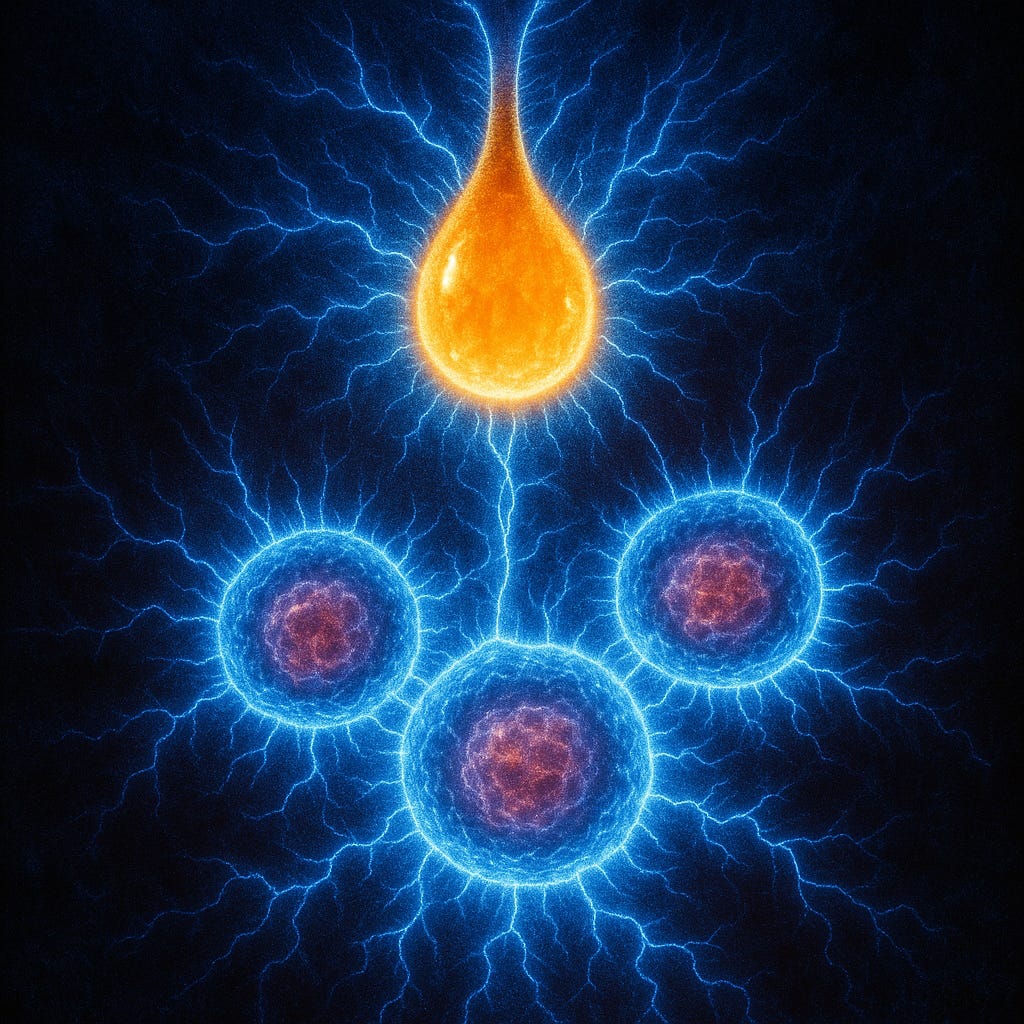
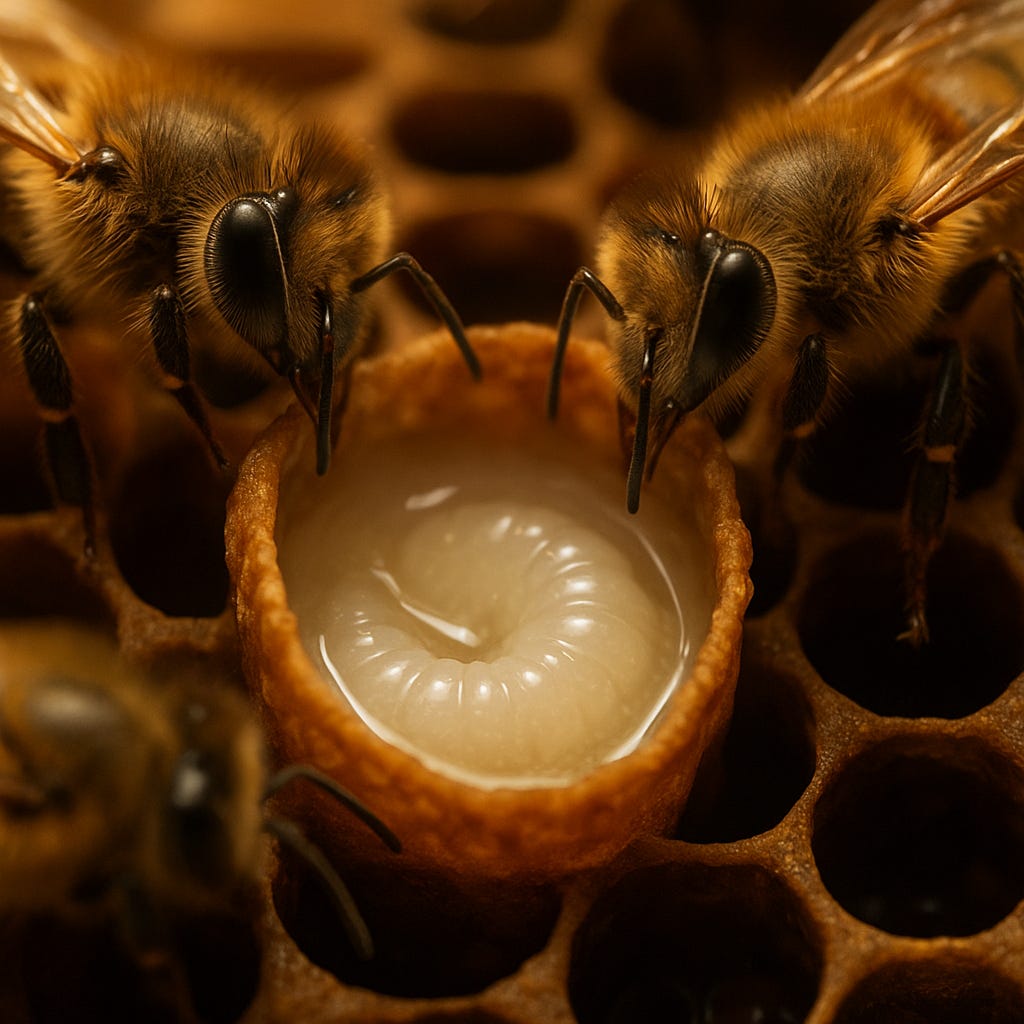
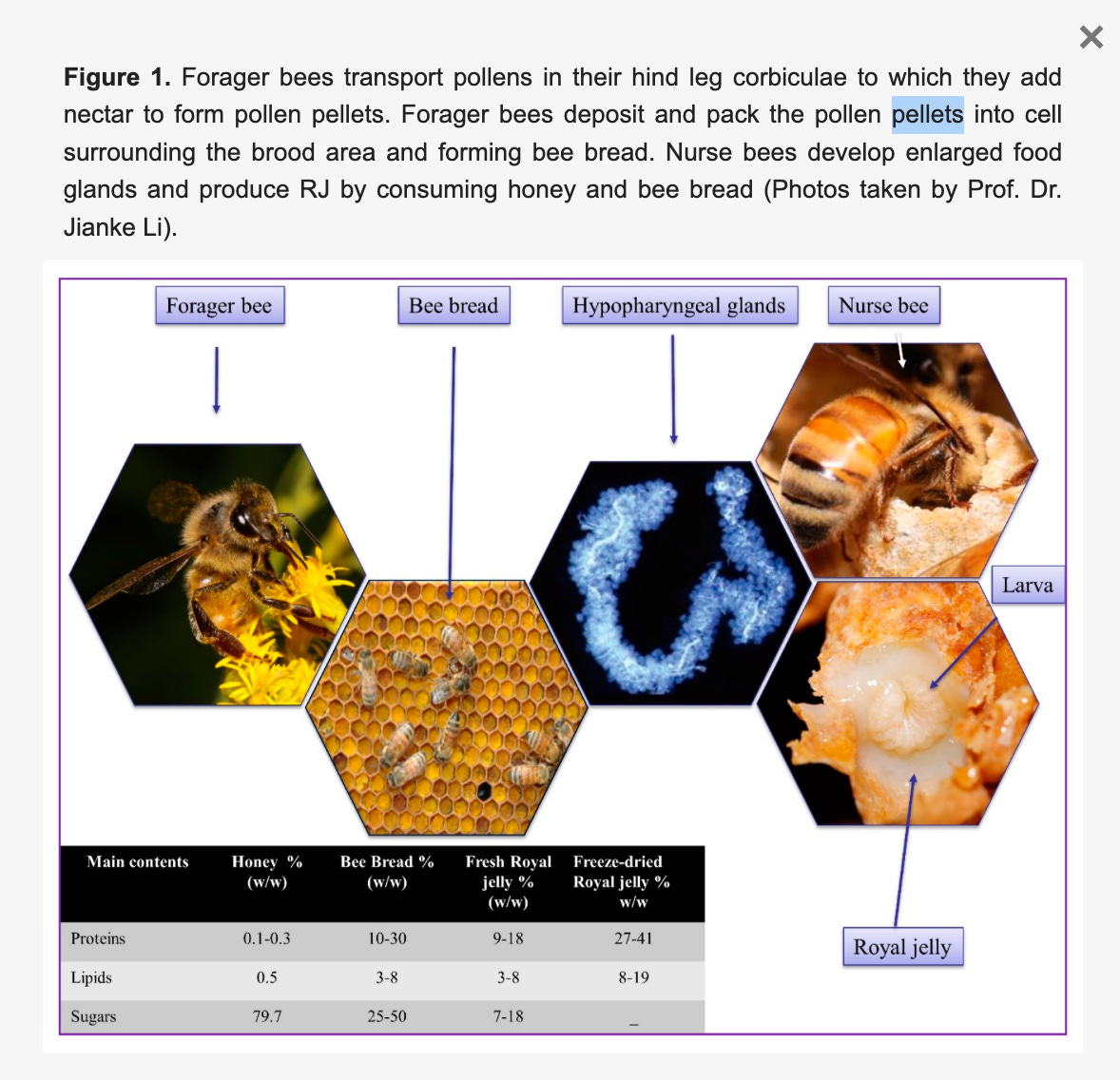

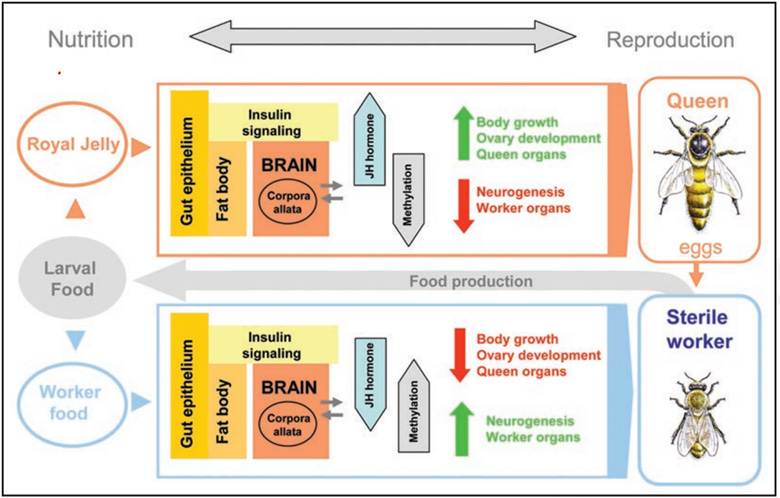
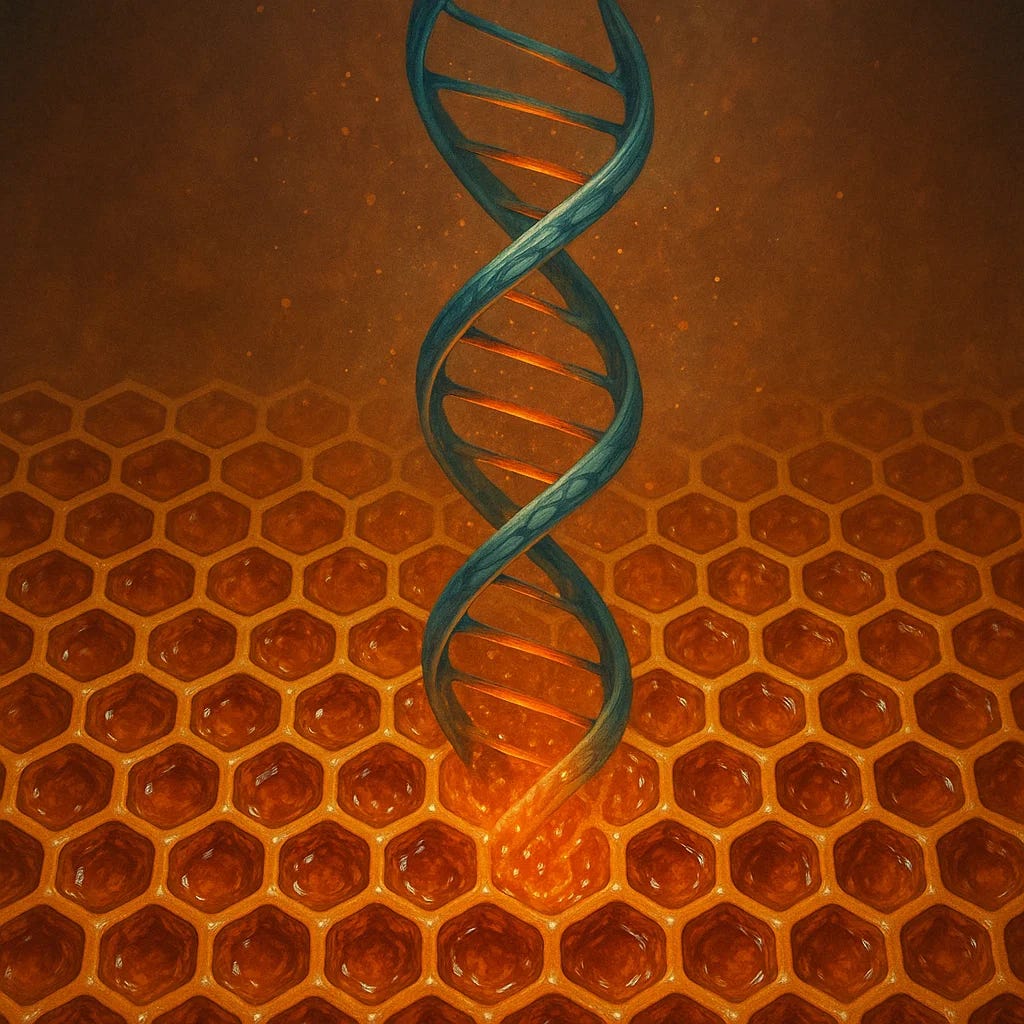

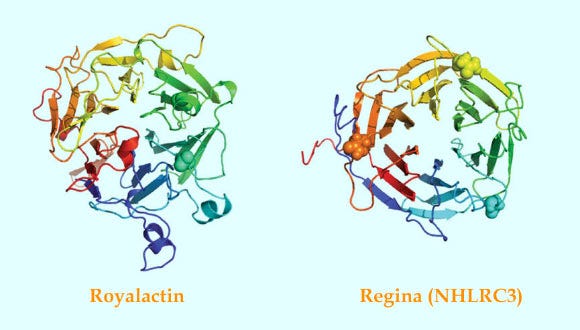
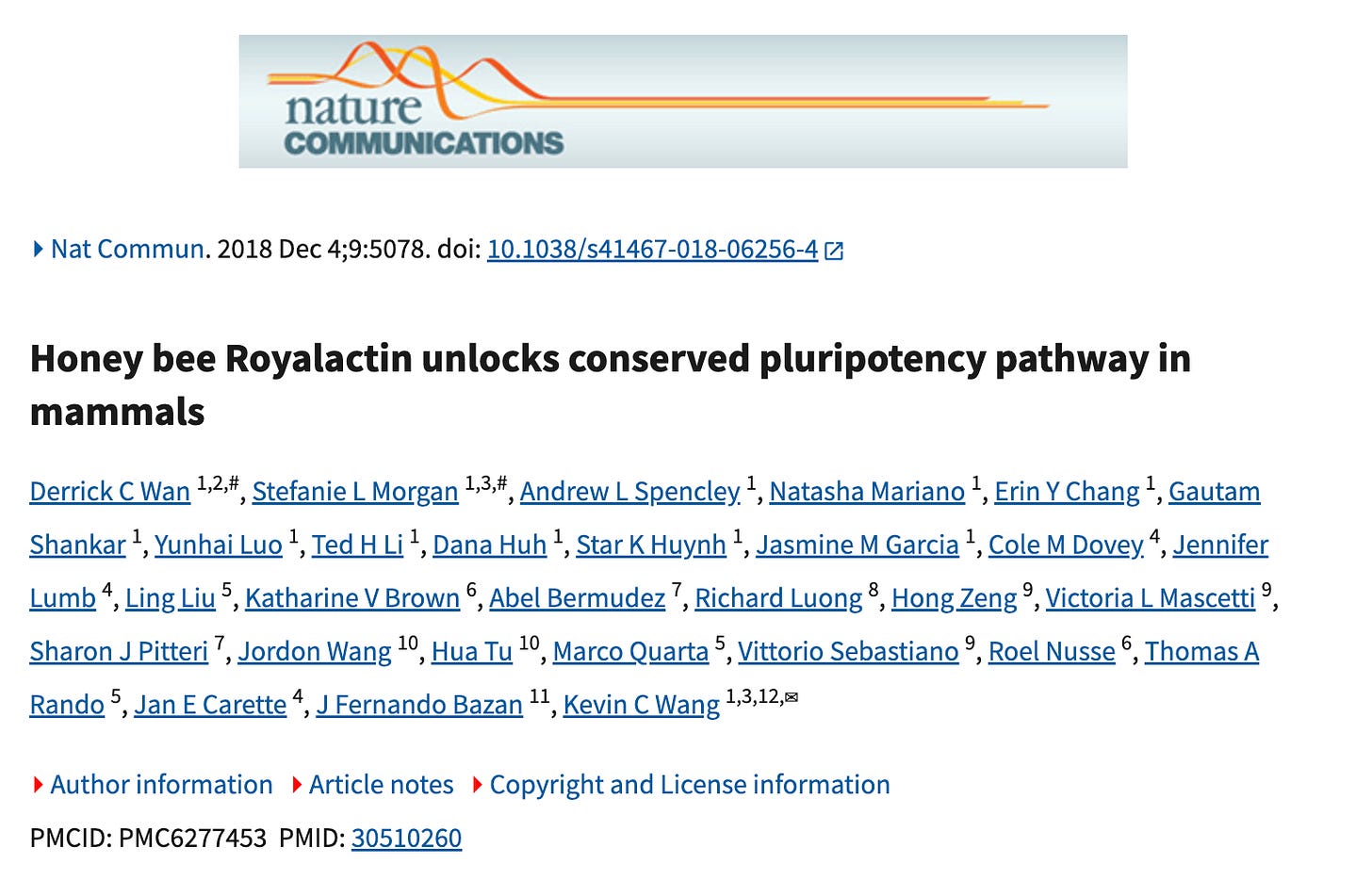
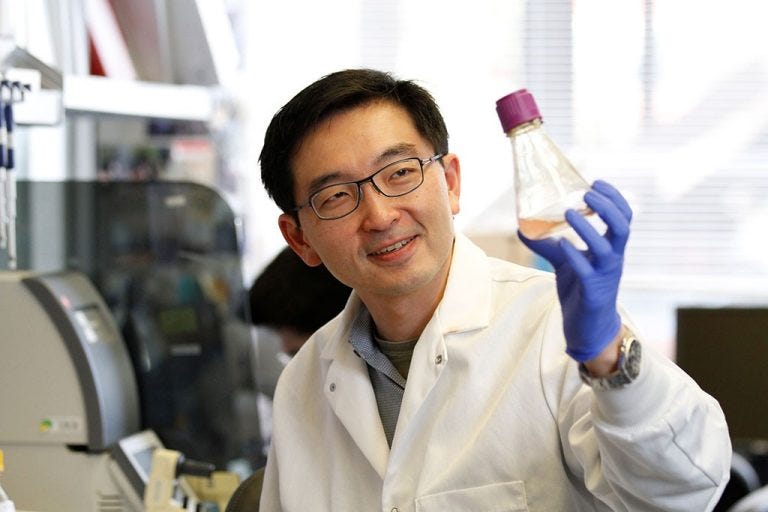
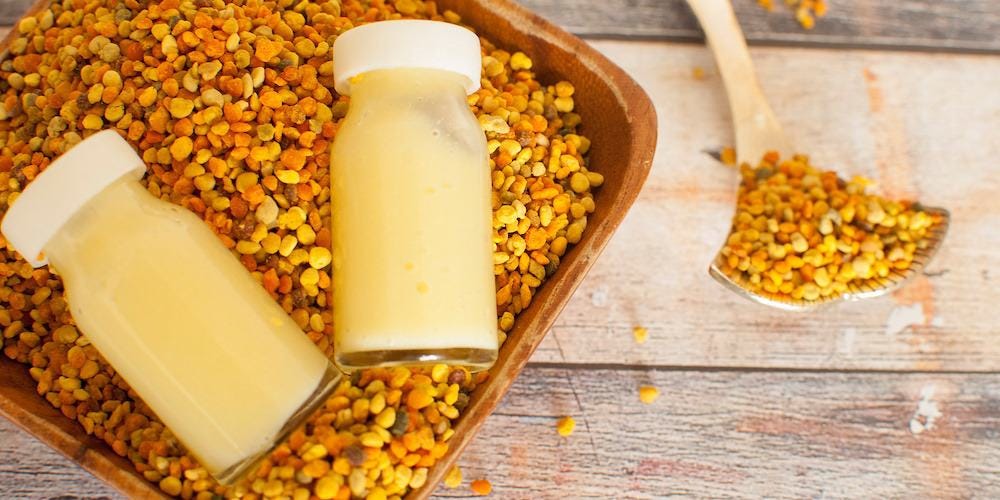
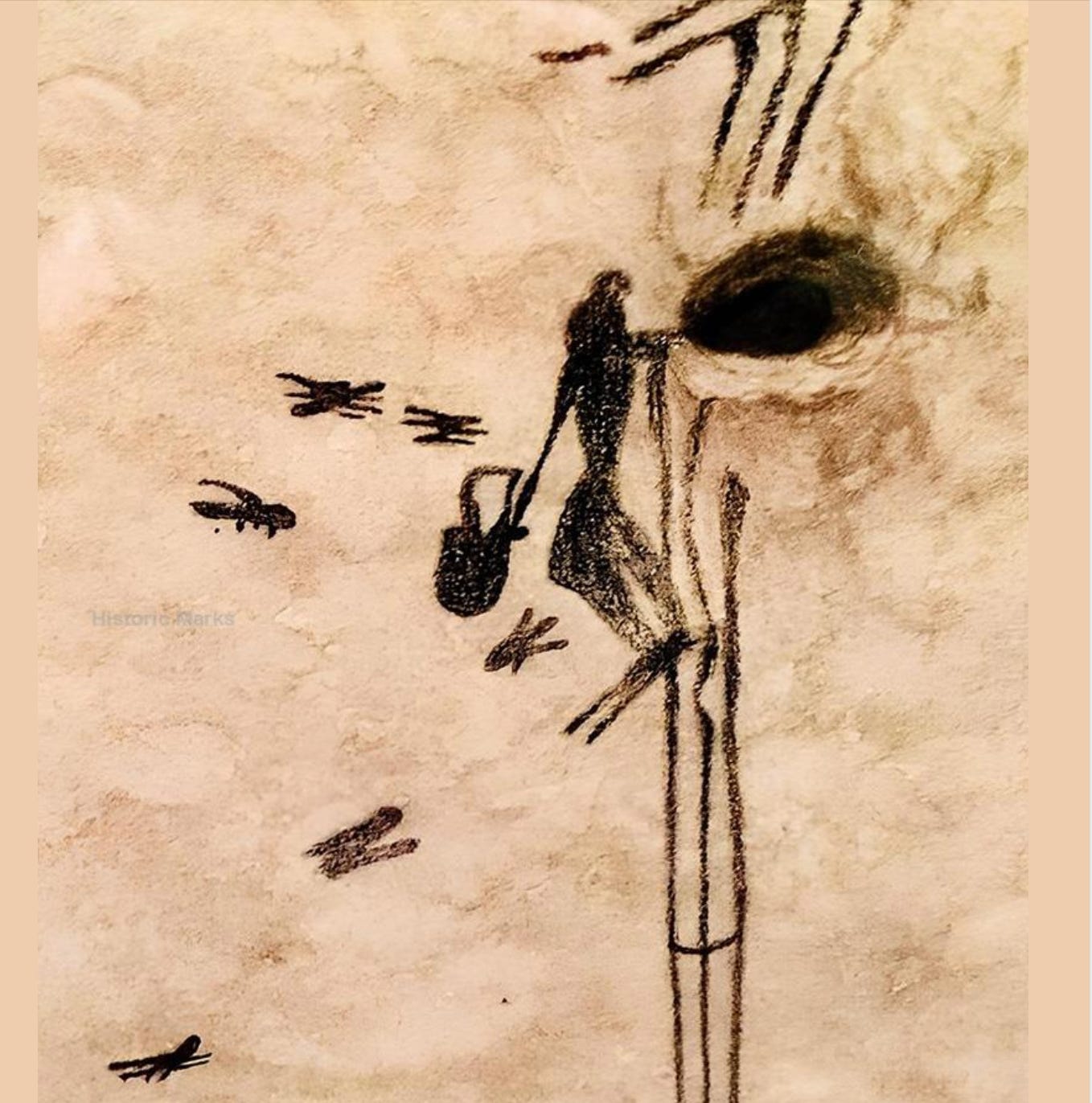




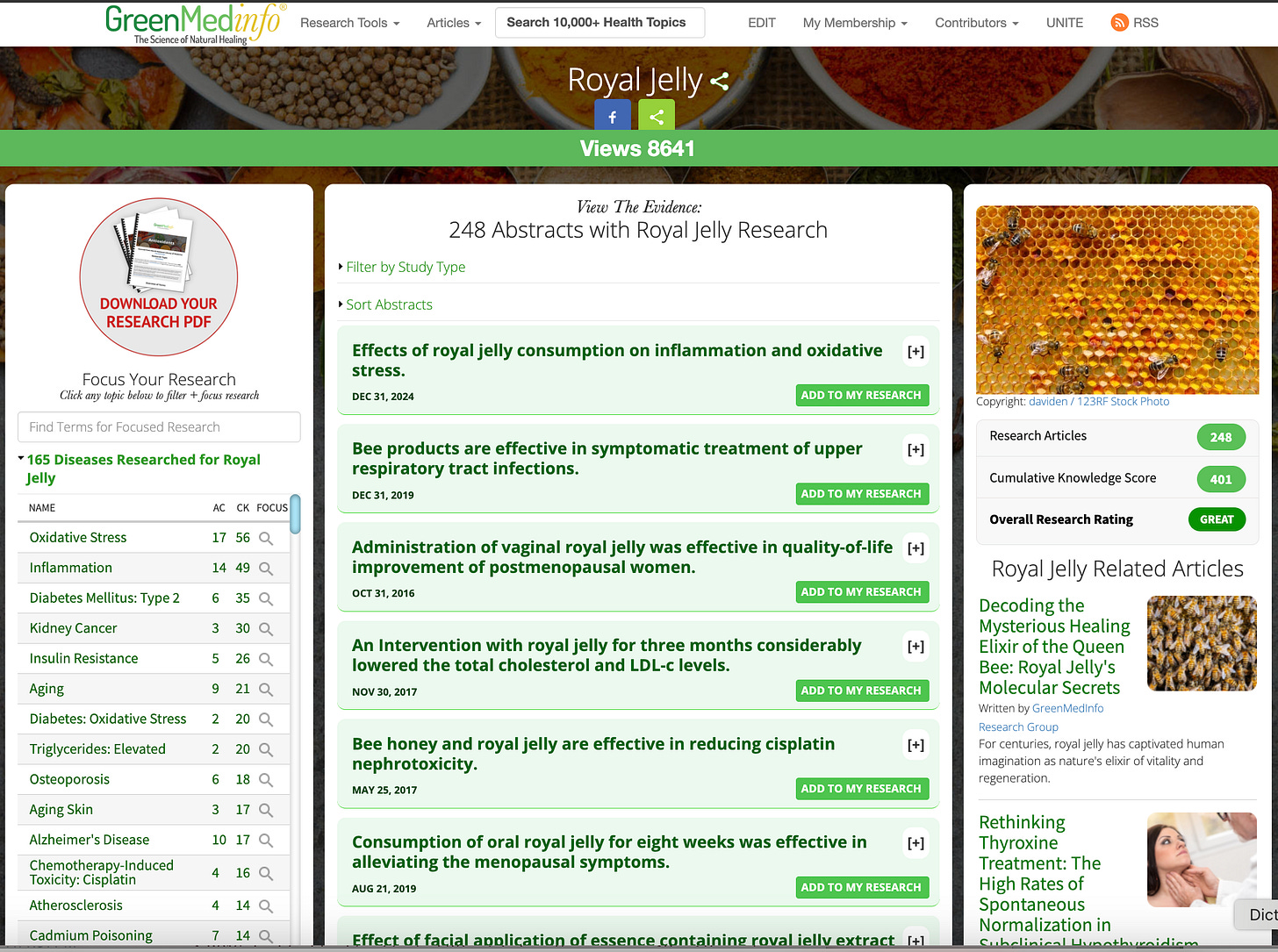
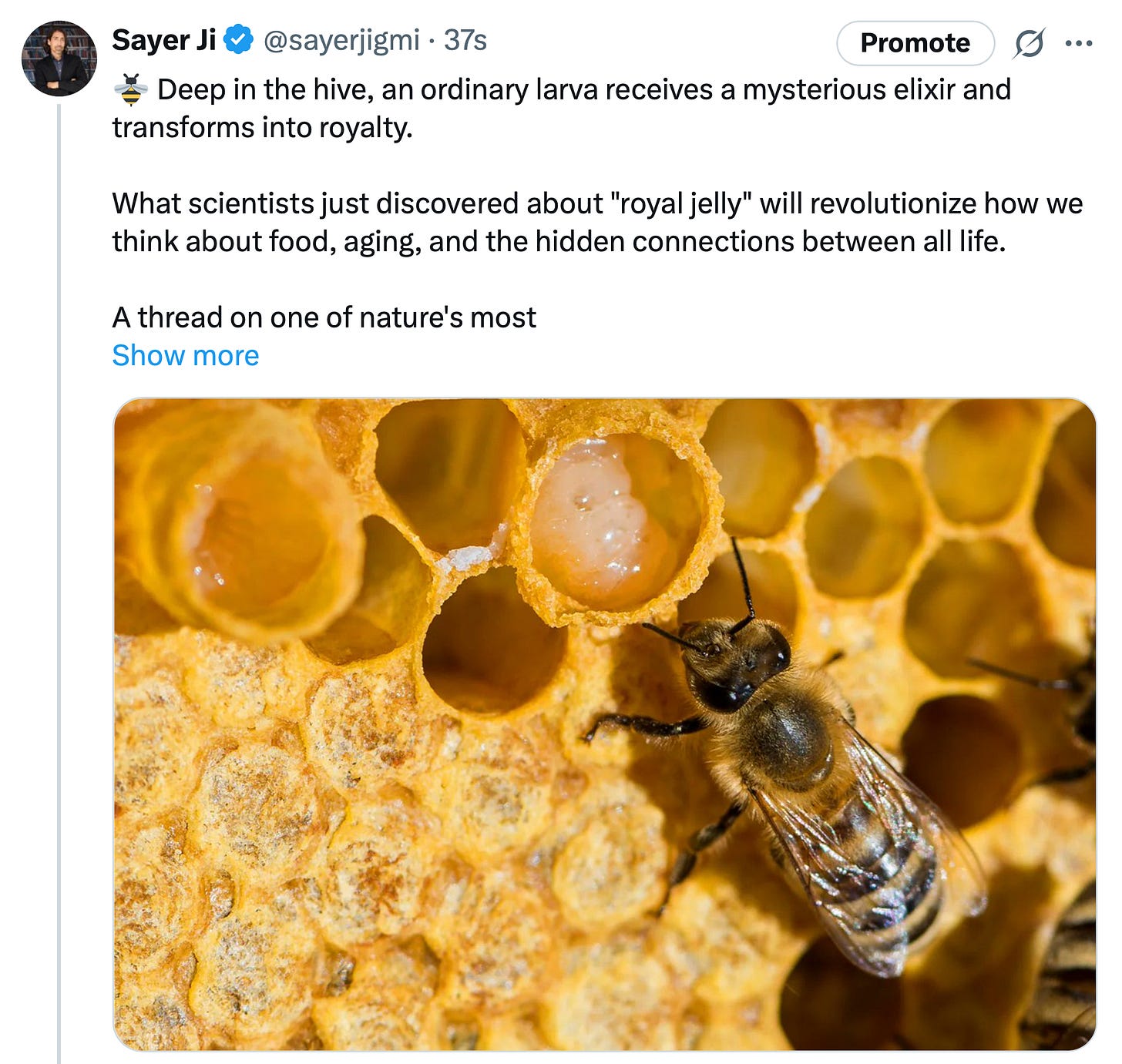

No hay comentarios:
Publicar un comentario